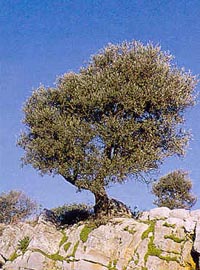
|
|
Cultivated olive trees belong to the botanical group Sativa which, together with oleaster, a cousin of the same plant, are a sub-species of the Olea europaea. The Mediterranean, with its hot dry summers and cool winters with soft rains, is the ideal habitat of this tree. Olive trees are not particularly demanding and can be grown on poor stony ground, unsuitable for other crops. An evergreen, it takes the olive tree 5 to 8 years to produce its first fruit, but the tree has an extremely long and productive life: up to 600 years, sometimes more. There are over 75 varieties of olives. 2. ETYMOLOGY The word "olive" has European and Asian roots that denote its origin. It can be traced as far back as the Cretan word "elaiwa" and the Semitic word "ulu", becoming "oleum" in Latin. On the other hand the Spanish word for oil, "aceite", has a totally different origin and comes from the word "zait" and "zaitum" in Arabic.
Olive oil is the oil obtained from the fruit of the olive tree in a mechanical manner: the liquid is pressed out of the fruit of the olive tree and then separated from the mass of the squashed fruit by centrifugal force or else by precipitation. 4. FIRST APPEARANCE OF THE OLIVE TREE IN THE MEDITTERANEAN There is no way of knowing when the olive tree first made its appearance. It is as if this tree wanted to keep its secret forever, making us believe it is as old as the world, as sacred as the oldest mysteries, a precious and unique gift from the gods to mankind. It is impossible to imagine Greece without the tree that gives it life, the olive tree. Beyond historical and archaeological facts, only mythology has the power to explain its origins… Next: Olive Oil Recipes |
|



